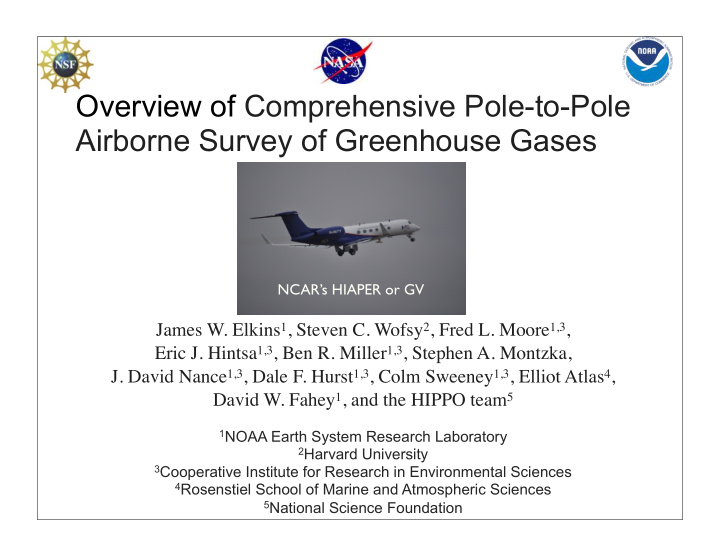



Overview of Comprehensive Pole-to-Pole Airborne Survey of Greenhouse Gases NCAR’s HIAPER or GV James W. Elkins 1 , Steven C. Wofsy 2 , Fred L. Moore 1,3 , Eric J. Hintsa 1,3 , Ben R. Miller 1,3 , Stephen A. Montzka, J. David Nance 1,3 , Dale F. Hurst 1,3 , Colm Sweeney 1,3 , Elliot Atlas 4 , David W. Fahey 1 , and the HIPPO team 5 1 NOAA Earth System Research Laboratory 2 Harvard University 3 Cooperative Institute for Research in Environmental Sciences 4 Rosenstiel School of Marine and Atmospheric Sciences 5 National Science Foundation
!"##$%"&'()*+,&(-./& % Multiple measurements: Red symbols ! 3, Blue = 2; sampling rates in ().
HIPPO itinerary HIPPO_2 Nov 2009 preHIPPO Apr-Jun 2008 HIPPO_3 Apr 2010 HIPPO_1 Jan 2009
HIPPO1 (SB) NOAA PANTHER CH 3 Br & HCFC-141b
HIPPO1 (SB) NOAA SF 6 & CO 2
HIPPO1 (SB): Uptake of CO 2 and source of O 2 in Southern Ocean.
!"##$%&%'()%*%'()%+$,,%-'./0(1.'234.%-056'.780(8% slide: B. Stephens
HIPPO1 (SB) High Resolution N 2 O shows tropical source from convection
!"#$%"&>-)(4-$?@#.&#A&, / 0&3B-))-#.)C&&DE<<0&F4#))&)3F@#.)1&GH'I&I#73"& !"#$%"&'#(%")&*'+&,&-.&, / 01ê&56&7%8)9& &&&&&&&&&&&&&&&&5:;&&&&&&&&&&&& & &<#)(34-#4&&&&&&&&&&&&&&&&&&&&&&&&&&;:=& !!!!!!!!!!!!!!!!"#$ ! ! !!!!!!!!!%&'(&! ! !!!!!!! ! !!!"#)*! +&',!-(&.!/01&21&345!!%&16'&!%1.&17!-89.1&(!:;<'='>1!/?@ABC+D4! Kort et al., 2011, GRL, in review.
NOAA’s Cooperative Flask Sampling Network • • • Flasks: ALT • BRW SUM • Weekly ETL • Daily PFA mhd • LEF ESP • • Bi-wkly • NHA • • wlg (Aircraft) HFM THD HAA NWR wis • • TGC MLO KUM • SMO RTA • CGO • tdf • PSA • SPO
60-90 ° N 30-60 ° N 0-15 ° N Altitude (m) HIPPO1 Dark blue = HIPPO gnd gnd gnd Gnd: sum, brw, alt Gnd: nwr, lef, hfm, Gnd: mlo, kum Air: pfa, elt thd, mhd Air: haa, tgc Air: esp, nha, etl January COS (ppt)
2-11 November 2009, Southbound ! High loadings of BC observed in the Arctic; well stratified plumes from Asia, Europe, and North America ! BC as a tracer of Photo: E. Kort isentropic transport Asian and North American pollution Warm Conveyor Belt ! Long-range 14-21 November 2009, Northbound biomass burning plumes observed in southern hemisphere from Africa and South America ! Very low BC loadings in the deep tropics Long-range biomass burning plumes Spackman et al. , in preparation
2-11 November 2009, Southbound ! High loadings of BC observed in the Arctic; well stratified plumes from Asia, Europe, and North America Photo: E. Kort ! BC as a tracer of isentropic transport Asian and North American pollution Warm Conveyor ! Long-range Belt 14-21 November 2009, Northbound biomass burning plumes observed in southern hemisphere from Africa and South America ! Very low BC loadings in the deep tropics Long-range biomass burning plumes Spackman et al. , in preparation
Methane release from sea leads • HIPPO2: We found that the ocean releases CH 4 to the air when it is not ice-covered. This is unexpected and indicates that reduction in ice cover has by itself probably increased CH 4 flux to the atmosphere even in the absence of a change in CH 4 release rates from clathrates. • HIPPO3: Low O 3 in the presence of high CH 4 over sea leads. • HIPPO was also a carbon cycle (not just CO 2 ) mission, and this result for CH 4 may change our understanding of Arctic sources.
Summary of HIPPO/1-3 • First snapshot of complete troposphere for many GHGs and black carbon. • Summertime uptake of CO 2 and sources for O 2 at high southern latitudes. NOAA’s CarbonTracker does a good job of reproducing this result for CO 2 . • Fine scale variability observed for N 2 O at altitude from Asian Sources over NH • Comparisons of NOAA ground based/small aircraft to HIPPO COS show consistent gradients-sources and sinks, but small differences noted in mixing ratios. • Models predict higher black carbon levels, Asian and N. American Sources seen. • High source of boundary layer CH 4 around sea leads.
HIPPO Science Team: Harvard University: ( QCLS, OMS ) S. C. Wofsy, B. C. Daube, R. Jimenez, E. Kort, J. V. Pittman, S. Park, R. Commane, Bin Xiang, G. Santoni; ( GEOS-CHEM ) D. Jacob, J. Fisher, C. Pickett-Heaps, H. Wang, K. Wecht, Q.-Q. Wang; National Center for Atmospheric Research: B. B. Stephens, S. Shertz, P. Romashkin, T. Campos, J. Haggerty, W. A. Cooper, D. Rogers, S. Beaton, R. Hendershot; NOAA ESRL and CIRES: J. W. Elkins, D. W. Fahey, R. S. Gao, F. Moore, S. A. Montzka, J. P. Schwarz, D. Hurst, B. Miller, C. Sweeney, S. Oltmans, D. Nance, E. Hintsa, G. Dutton, L. A. Watts, J. R. Spackman, K. H. Rosenlof, E. A. Ray; Princeton: M. Zondlo, Minghui Diao JPL: M. J. Mahoney; (AIRS) M. Chahine, E. Olsen; UCSD/Scripps: R. Keeling, J. Bent; U. Miami: E. L. Atlas, R. Lueb; Cooperating modeling groups: ACTM P. Patra, K. Ishijima ; GEMS-MACC R. Engelen ; ( GEOS-Chem, U. Toronto ) R. Nassar, D. B. Jones, ( TM3/TM5 ): Sara 16 Mikaloff-Fletcher
Extra Slides
NOAA CCGG data confirms the high N 2 O, but 1/2
HIPPO1 (SB) NOAA UCATS O 3 & H 2 O
Seasonality in hemispheric means—marine/high alt. NH sites Surface stations only Annual seasonality SH over 2000-2005 NH NH = MLO KUM NWR BRW ALT H1 H3 H2
4&*+%M4+(,5.+)+<7 3&)9(.6,&< • !"#!$%&'(%!)&*+%,!-.&)! /012324!,567+!8&)9(.+*!7&! &',+.:(;&<,= • >.+?!.+$6&<!.+9.+,+<7,!)&*+%! .(<$+=!! • !3&%&.+*!9.&@%+,!(.+!ABCD! )+(,5.+*!E&<(%!(:+.($+, • !4&*+%,!&:+.+,;)(7+!F3!)(,,! %&(*,!'?!(!-(87&.!&-!GH!&<! (:+.($+=! • I<,5J86+<7!.+)&:(%!&-!F3! 6*+<;@+*!(,!(!%6K+%?!,&5.8+!&-! 7L+!'6(,= A8LN(.EH!+7!(%=H! !"#$ !CO"O
60-90 ° N 30-60 ° N 0-15 ° N Altitude (m) HIPPO3 Dark blue = HIPPO Gnd: sum, brw, alt Gnd: nwr, lef, hfm, Gnd: mlo, kum Air: pfa, elt thd, mhd Air: haa, tgc Air: esp, nha, etl Mar-Apr COS (ppt)
60-90 ° N 30-60 ° N 0-15 ° N Altitude (m) HIPPO2 Gnd: sum, brw, alt Gnd: nwr, lef, hfm, Gnd: mlo, kum Air: pfa, elt thd, mhd Air: haa, tgc Air: esp, nha, etl Oct-Nov COS (ppt)
Recommend
More recommend